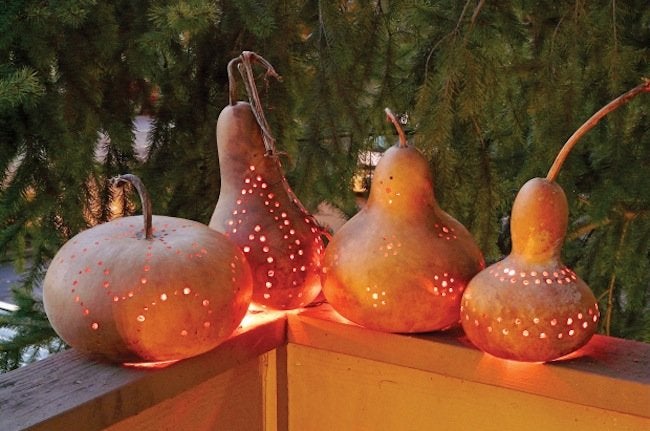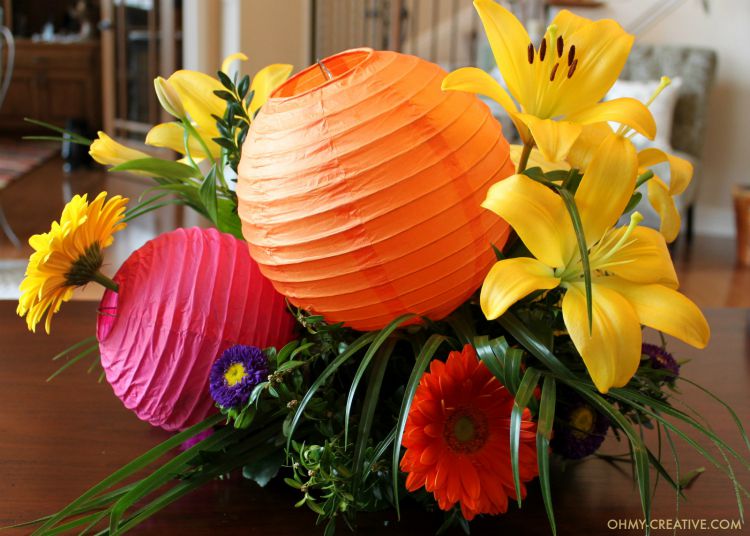How to Craft with Gourds

Gourds for crafting are called "hard-shell gourds." They're green in the field, but after harvest, they slowly dry out, leaving a woody shell and lots of crafting possibilities. You can often find them at farmer's markets in early fall or online from retailers such as Welburn Gourd Farm or Amish Gourds.
Here's a rundown on gourd crafting, courtesy of my mom, Pam Harris.
What you'll need:
Hard-shell gourdLarge bucket of waterScrub spongeTowelPencil with eraserPumpkin-carving sawSmall paring knife with a sharp pointGarden glovesDust or surgical maskEmbellishment materials (discussed below)
Choosing a Gourd
Select your gourd based on a shape that is pleasing to you or that will work well for the project you have planned. For instance, a very round gourd with a flat bottom will be more stable as a flower vase than a tall, thin gourd would be.
Look for cracks in the gourd's surface. Although a cracked gourd could be used for a project where you will be cutting out the cracked portion, it's usually better to start with a gourd that is free of cracks, as the area around the crack is very delicate.
Sometimes a gourd will have a "mouse hole" in it. If I like the shape of the gourd and the hole is in a "convenient" place, I will go ahead and use it for a project.
Don't let the surface mold and grime affect your decision in selecting a gourd. The mud, grime, and mold that accumulated during the drying process can usually be easily removed.
 Scrub dirt and mold from the gourd's surface.
Scrub dirt and mold from the gourd's surface.
Cleaning a Gourd
This is a simple process. Just soak the gourd in water for about 10 minutes, then scrub it with a heavy-duty scrub sponge (I use Scotch Brite, which has a nice, rough surface).
Most gourds can be cleaned in less than 10 minutes. Some areas of mold and dirt will come right off with light rubbing; others will take a little more effort. After cleaning, allow the gourd to dry for about 30 minutes.
Some gourds will have natural discoloration that appears in a random, uneven pattern. This can't be removed-it's best to consider it part of the natural beauty of the gourd.
 Pierce the wall of the gourd with a paring knife.
Pierce the wall of the gourd with a paring knife.
Cutting the Gourd
Place the gourd on newspaper or a towel pad. Use a pencil to draw an outline on the gourd of the hole you want to cut. Using the point of a paring knife, pierce the gourd shell anywhere along the line. This will take fairly gentle pressure, but be careful of the knife slipping on the gourd shell. Pierce all the way through the shell.
 Continue cutting with a pumpkin-carving saw.
Continue cutting with a pumpkin-carving saw.
Insert the pumpkin-carving saw into the slot made by the paring knife, and gently saw the gourd shell along the line you drew. For better stability, saw with the part of the blade that's closest to the handle. Any pencil marks left on the surface of the gourd after you've cut it can be removed with an eraser.
Be sure to save the piece you just cut from the gourd shell. Shell pieces are useful for testing finishes, stains, paints, practicing cutting techniques, experimenting with new tools, etc.
CAUTION:
Gourd dust and pulp can be somewhat irritating to some people, so I suggest cutting and cleaning your gourd outdoors or while wearing a dust mask.
 Dried pulp inside the gourd will be either a solid mass or a mix of broken pieces and seeds.
Dried pulp inside the gourd will be either a solid mass or a mix of broken pieces and seeds.
Cleaning Out the Pulp
The pulp inside your gourd will have dried either as a solid mass or as a dusty mixture of seeds and pulp pieces. It is fairly easy to determine the kind of dried pulp inside the gourd by shaking it. If you hear a thunk inside, the pulp is a solid mass. If you hear a rattle, you have loose seeds and pulp.
 Scoop the pulp out of the gourd.
Scoop the pulp out of the gourd.
Loose seeds and pulp usually fall right out of the opening. Solid pulp masses are sometimes larger than the opening and require breaking up with your gloved fingers or the paring knife so that the pulp can be removed. If any pieces of pulp remain stuck to the walls, you can remove them by rubbing the inside surface with your gloved fingers or using a scraping tool such as an old spoon.
 Smooth the cut edge with a file or sandpaper.
Smooth the cut edge with a file or sandpaper.
Smoothing the Cut Edge
The cut edge of the opening usually appears a little rough. This can be smoothed out somewhat by rubbing your gloved fingers over the surface of the cut edge. If you wish the edge to be even smoother, use a file or fine sandpaper.
 Gently press an awl into the gourd wall to make a hole.
Gently press an awl into the gourd wall to make a hole.
Drilling Holes
If you plan to make a birdhouse from your gourd, then you may want to drill a hole to install a skewer as a perch. You can easily punch holes in your gourd with an awl-just apply gentle pressure and twist the awl a little until it passes through the wall of the gourd.
 Apply shoe polish to the gourd to add soft color and natural protection.
Apply shoe polish to the gourd to add soft color and natural protection.
Finishing the Surface
If you prefer to keep the surface of the gourd looking natural, you can spray it with polyurethane spray varnish. Another good method is to apply mineral oil to the surface with cotton balls and polish it-this leaves a soft glow.
 Polish the gourd for a soft shine.
Polish the gourd for a soft shine.
I like to apply crème shoe polish with a soft cloth and buff, as shown. The shell will accept the color nicely. Use natural to light brown to preserve the natural appearance of the gourd.
You certainly can use the gourd unfinished as well-just keep in mind that it won't be too permanent without some surface protection.
 Water-based or permanent markers are great for adding color.
Water-based or permanent markers are great for adding color.
Adding Embellishments
A prepared gourd takes marking pens beautifully, and they're especially fun and easy for kids. Both water-based and permanent ink pens will work. Round-tip Sharpies come in sets of several colors, dry instantly, and provide good coverage.
 Colored pencils provide a softer finish.
Colored pencils provide a softer finish.
Colored pencils provide a softer look and are also good for children. However, since the surface of the gourd is uneven, it can be harder to get good coverage. To work the pencil pigment into the little pits of the gourd surface, try cutting a cotton swab stick in two, and rubbing the cut end of the stick into the pencil marks.
At the top of this post, you can see a gourd that has been decoupaged with pressed flowers. Mod Podge is great for applying images from magazines, stickers, or dried natural material. The results are very impressive!
This is only the beginning! You can also stencil images on a gourd, or stamp it with rubber stamps, or paint it with acrylic paints. There are so many design possibilities.

 A drinking glass provided the cutting template. Pick a size circle that best suits your purposes. Two-inch circles will make the flowers look more precious while five-inch circles will add impact. (Be sure your paper is stiff enough to maintain its shape if you opt for making the larger blossoms.)
A drinking glass provided the cutting template. Pick a size circle that best suits your purposes. Two-inch circles will make the flowers look more precious while five-inch circles will add impact. (Be sure your paper is stiff enough to maintain its shape if you opt for making the larger blossoms.) Use decorative-edge scissors, like scallop or zigzag, to cut your green cardstock.
Use decorative-edge scissors, like scallop or zigzag, to cut your green cardstock. Cut slowly and carefully with your X-Acto knife, and make sure you are using a fresh, sharp blade.
Cut slowly and carefully with your X-Acto knife, and make sure you are using a fresh, sharp blade. If you want, you can use different fabrics for each leaf and berry; just make sure they fully cover each cut-out shape.
If you want, you can use different fabrics for each leaf and berry; just make sure they fully cover each cut-out shape. Press lightly on the green cardstock to affix to the red card.
Press lightly on the green cardstock to affix to the red card.













